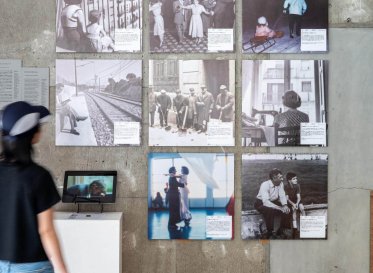
The Fuji Textile Collaborative Project kicks off in
Fujiyoshida City (II)
Samira Boon Studio’s textile research report
Exploring textile innovation: The Fuji Textile Collaborative Project
Traditional textiles and pioneering innovation in Fujiyoshida City
Fujiyoshida City, located just an hour and a half by express bus from Tokyo, boasts a rich textile heritage dating back over a millennium, thriving on the fertile landscapes and pristine water from Mount Fuji. Today, it’s a hub of tradition and innovation, hosting events like factory visits, popular craft markets like Hataori Festival, and Japan’s first textile art festival, the renowned Fuji Textile Week. All of these initiatives are aimed at reinventing textiles through collaborations with diverse creators and artists.

A project to further empower the local industry: the Fuji Textile Collaborative Project kicks off in 2023
The Fuji Textile Collaborative Project aims to unlock the potential of textiles in architecture, spatial design, product design, and art by fostering collaboration between Yamanashi Prefecture textile producers and international creators. This initiative seeks to create a framework for blending the region’s unique textile technology with global creativity, forging connections between local and global industries.
The project kicked off its three-year plan in December, with Dutch designer Samira Boon embarking on a research trip to Fujiyoshida.

Research Trip in Fujiyoshida
A research program delving into the sophisticated techniques and wisdom of Fujiyoshida's weaving factories
Based in Amsterdam and Tokyo, Studio Samira Boon is a textile architecture studio that focuses on creating flexible and dynamic environments. The studio specializes in applying cutting-edge technology to fabric design for renowned clients and institutions like Hermès, Theaters Tilburg, and the International Space Station, among others. Through the use of high-tech folding techniques and computer weaving models, they continuously create unique expressions in textiles.
Samira Boon, with prior experience studying and residing in Japan, possesses deep expertise across various facets of Japanese textile crafts and recent advancements. However, her visit to Fujiyoshida marked her first immersion into the Yamanashi textile industry. Beyond factories and weaving workshops, the town hosts a spectrum of stakeholders, such as dye houses, yarn suppliers, researchers, and skilled artisans. Leveraging Samira’s proficiency, the Fuji Textile Collaborative Project team tailored a research program to her strengths, facilitating a comprehensive exploration of Fujiyoshida’s textile landscape and fostering a deeper understanding of its industry.
On the first day of the five-day visit to Fujiyoshida, Samira visited the Yamanashi Industrial Technology Center, popularly known as “Shikenjo,” to participate in an introduction Fujiyoshida’s weaving history, trends, and techniques. The Center’s experts shared with her the valuable archives of Kaiseki silk, providing a solid foundation for the research program starting the next day.

Following the visit to the Yamanashi Industrial Technology Center, Samira embarked on a tour of numerous weaving sites in and around Fujiyoshida alongside the project team. Witnessing the unwavering commitment to quality demonstrated by each weaving workshop, Samira, with her extensive involvement in various projects emphasizing the significance of technology, posed insightful questions. Furthermore, she explored a spot in Minobu City renowned for washi (traditional Japanese paper), delving into the distinctive traits of local washi paper and the ongoing experimentation of washi-based textiles and yarns in the area.

One day of the program featured special guests alongside Samira: a team led by Professor Tachi from the University of Tokyo, which researches three-dimensional shapes, and artist Asao Nogoro, who designed the emblem for the 2020 Tokyo Olympics and Paralympics.
Over the five days, Samira visited a total of five regional industry stakeholders, carefully listening to their insights into Fujiyoshida’s industries and the unique characteristics of each. Time always seemed insufficient as questions overflowed, but she was able to gain deep insights into each weaving workshop.

Furthermore, the program also included the opportunity to attend selected exhibits of Fuji Textile Week. These showcases served as a wellspring of creative inspiration, highlighting the dynamic interplay between textile, art, and design.

Thinking Session with Professor Tachi and weavers
The research trip concluded with a collaborative thinking session involving not only the visited weaving workshops but also those that could not be visited during this visit. During this session, Samira introduced soundproof textiles used in her interior designs and fabrics with three-dimensional properties inspired by Japanese folding techniques, some of which she co-created with Professor Tachi. It was an enlightening session that explored new possibilities in textiles.


With the research trip successfully concluded, the project will now transition to the production phase starting this year. Stay tuned to witness the innovative creations that emerge from the collaboration of designers and producers, combining their knowledge, experience, and techniques.

Project Overview
- International Collaborators: Raw Color Studio, Studio Samira Boon
- Local Collaborators: Funakubo Orimono, Oyamada Co., Ltd., Tenjin Factory, Maeda Gensho Shoten, Watoko Orimono, Watanabe Orimono, Marukousan Industry Co., Ltd., Fujichigira Co., Ltd., Hikari Orimono, Makita Shoten, Miyashita Orimono, Yamajyu Seishi
- Project Management: FabCafe Tokyo, DOSO Inc., FabCafe Fuji
- Creative Director: Arieh Rosen
- Special Thanks: Yamanashi Prefecture, Embassy of the Kingdom of the Netherlands in Japan, Dutch Creative Industries Fund, Yamanashi Industrial Technology Support Center
Guest Creator
Next Contents










